William Raymond Eaton Paintings
William Raymond Eaton, born in 1865, was an English artist whose life and career spanned the late 19th and early 20th centuries, a period marked by significant transformations in the world of art. Eaton's work, though not as widely recognized as some of his contemporaries, provides a fascinating glimpse into the artistic movements and societal changes of his time. Primarily known for his watercolor landscapes, Eaton captured the essence of the English countryside with a delicate touch and an eye for the intricate interplay of light and color.
Eaton's artistic journey began in earnest after he received formal training at the Royal College of Art in London, an institution that played a crucial role in shaping the talents of many British artists of the era. During his studies, he was influenced by the prevailing trends of the time, including the Arts and Crafts movement and the aesthetic principles advocated by the Pre-Raphaelite Brotherhood. However, Eaton carved out a distinct niche for himself by focusing on landscapes, a genre that allowed him to explore and express his personal vision and emotional response to nature.
Throughout his career, Eaton exhibited his work at various prestigious venues, including the Royal Academy of Arts and the Royal Watercolour Society. His exhibitions were met with positive reviews, and he gradually built up a modest but loyal following. Despite his successes, Eaton remained somewhat on the periphery of the mainstream art world, dedicating himself to his craft without seeking widespread fame or recognition.
Eaton's landscapes are characterized by their subtle use of color and light, often depicting serene scenes of the English countryside that evoke a sense of tranquility and timelessness. His paintings often feature rolling hills, quiet rural lanes, and idyllic rivers, rendered with a level of detail and sensitivity that speaks to his deep connection with the landscape. Eaton's work is reflective of the broader Victorian and Edwardian fascination with nature, seen as both a source of beauty and a refuge from the rapidly industrializing world.
William Raymond Eaton's life was tragically cut short when he died in 1907 at the age of 42. Despite his relatively brief career, he left behind a body of work that continues to be appreciated for its beauty and its contribution to the landscape genre. Today, Eaton's paintings can be found in various art collections and museums, where they stand as a testament to the enduring appeal of the English landscape and the skill of an artist who, though not widely known, offered a unique vision of the natural world.
